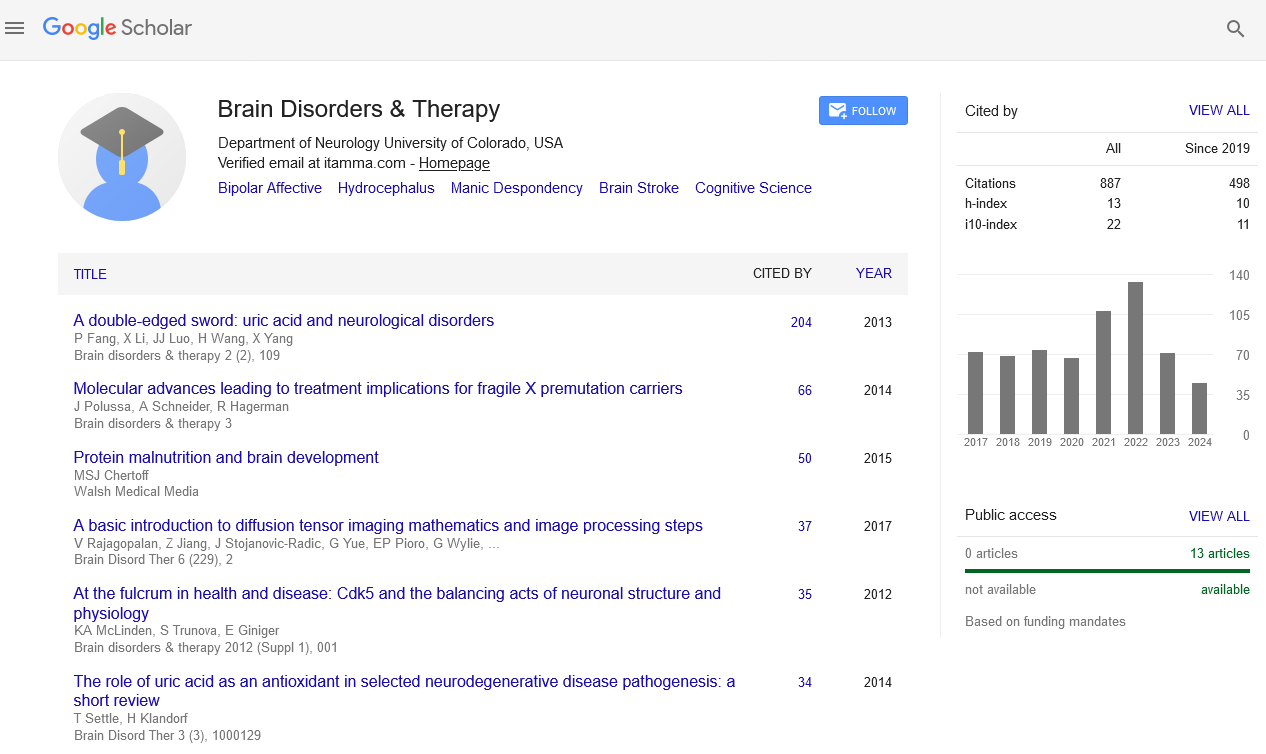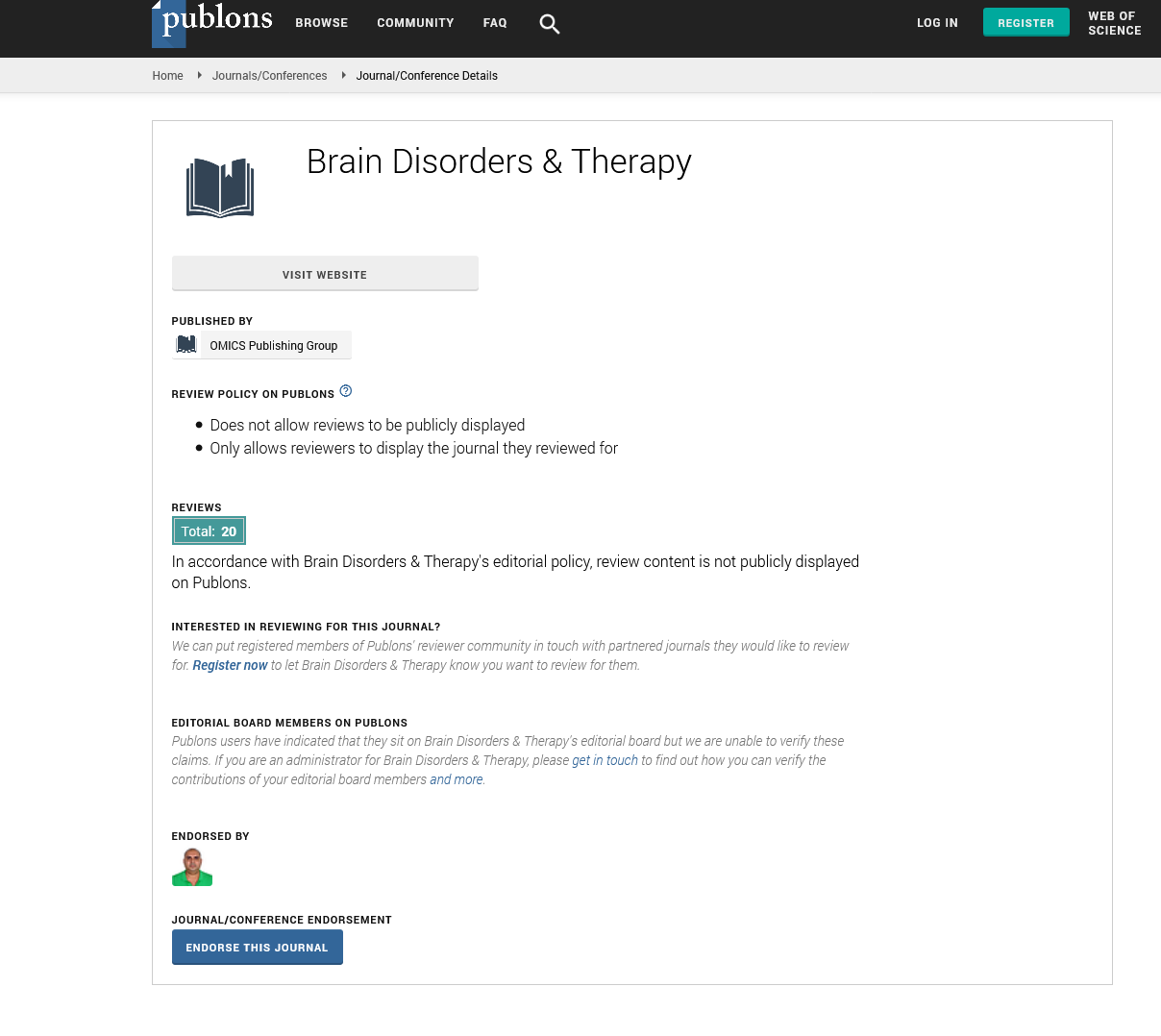Indexed In
- Open J Gate
- Genamics JournalSeek
- JournalTOCs
- RefSeek
- Hamdard University
- EBSCO A-Z
- OCLC- WorldCat
- Publons
- Geneva Foundation for Medical Education and Research
Useful Links
Share This Page
Journal Flyer

Open Access Journals
- Agri and Aquaculture
- Biochemistry
- Bioinformatics & Systems Biology
- Business & Management
- Chemistry
- Clinical Sciences
- Engineering
- Food & Nutrition
- General Science
- Genetics & Molecular Biology
- Immunology & Microbiology
- Medical Sciences
- Neuroscience & Psychology
- Nursing & Health Care
- Pharmaceutical Sciences
Commentary - (2025) Volume 14, Issue 2
Progress in Minimally Invasive Techniques for Brain Tumor Surveillance
Tracy Kilgore*Received: 26-May-2025, Manuscript No. BDT-25-29721 ; Editor assigned: 28-May-2025, Pre QC No. BDT-25-29721 (PQ); Reviewed: 11-Jun-2025, QC No. BDT-25-29721 ; Revised: 18-Jun-2025, Manuscript No. BDT-25-29721 (R); Published: 25-Jun-2025, DOI: 10.35248/2168-975X.25.14.301
Description
Primary and secondary brain tumors represent some of the most formidable challenges in oncology due to their complex biology, infiltrative nature and restricted accessibility. Gliomas, glioblastomas, medulloblastomas and metastatic brain lesions often exhibit aggressive clinical courses with limited treatment responses. Diagnosis and monitoring are further complicated by the Blood-Brain Barrier (BBB), which restricts the passage of many molecules, as well as the risks associated with invasive tissue biopsy. Conventional approaches such as MRI and surgical sampling provide valuable information but fall short in capturing the dynamic molecular evolution of tumors.
Molecular markers in liquid biopsy
The success of liquid biopsy in brain tumors depends on the reliable detection of tumor-derived biomarkers despite the challenges imposed by the BBB. Circulating tumor DNA fragments carry genetic mutations and epigenetic signatures reflective of the tumor’s genomic landscape, enabling mutation profiling without surgical intervention. Extracellular vesicles, actively secreted by tumor cells, contain DNA, RNA, proteins and lipids and can cross the BBB, making them particularly attractive markers. MicroRNAs, short non-coding RNAs with regulatory roles, show distinct expression patterns in different tumor types and grades, providing opportunities for classification and risk stratification. Although circulating tumor cells are less commonly observed in brain tumors compared to extracranial cancers, their occasional detection in advanced stages underscores their potential utility in specific contexts. Together, these molecular markers form the foundation of liquid biopsy approaches aimed at tackling the unique barriers of neuro-oncology.
Prognostic relevance
Beyond diagnosis, liquid biopsy holds promise as a prognostic tool. Genetic and epigenetic alterations detected through ctDNA or miRNA panels can provide insight into tumor aggressiveness, likelihood of recurrence and expected therapeutic response. For example, the detection of MGMT promoter methylation in ctDNA may predict responsiveness to alkylating agents such as temozolomide. Similarly, serial monitoring of mutational burden could offer an indication of treatment resistance or clonal evolution over time. By integrating molecular data obtained from liquid biopsy with clinical and imaging findings, clinicians can build more accurate prognostic models that guide therapeutic decision-making and follow-up intensity.
Monitoring treatment response
The management of brain tumors, particularly glioblastoma, is complicated by treatment resistance and frequent recurrence. Standard imaging often struggles to distinguish between tumor progression and pseudoprogression caused by therapy-related inflammation or necrosis. Liquid biopsy offers a complementary method for treatment monitoring by capturing dynamic molecular changes. Declines in ctDNA levels during therapy may correlate with treatment efficacy, while re-emergence or elevation can signal relapse earlier than radiographic changes. Similarly, EV-derived RNA or protein markers can provide real-time insights into tumor biology and therapy response. This capacity for longitudinal monitoring without the need for repeated invasive procedures represents one of the most compelling advantages of liquid biopsy, with significant potential to refine adaptive treatment strategies.
Overcoming challenges
Despite its promise, liquid biopsy in brain tumors faces considerable challenges. The BBB remains a fundamental biological barrier, restricting the release of tumor-derived material into circulation and limiting assay sensitivity, especially for small or low-grade tumors. Cerebrospinal fluid provides higher biomarker concentrations but requires lumbar puncture, which, while less invasive than brain biopsy, is not without risk. Standardization also poses a major hurdle. Differences in pre-analytical sample handling, biomarker isolation methods and analytical platforms lead to variability and hinder reproducibility across studies. Sensitivity and specificity are additional concerns, as brain tumors generally release lower biomarker levels than systemic cancers, necessitating ultra-sensitive detection technologies. Addressing these challenges will require collaborative efforts to harmonize protocols, validate assays in large patient cohorts and establish clinical guidelines for interpretation and application.
Ethical and practical considerations
As liquid biopsy moves closer to clinical translation, several ethical and logistical issues must be addressed. The handling of genetic information raises privacy concerns, particularly in pediatric and rare tumor populations where data sensitivity is heightened. Cost and accessibility are significant considerations, as advanced molecular platforms may be less available in low- and middle-income settings. Furthermore, liquid biopsy results must be interpreted within the broader clinical context to avoid over-reliance on isolated molecular findings. Integration with radiological and histopathological data remains essential to ensure accurate and responsible patient care.
Citation: Kilgore T (2025). Progress in Minimally Invasive Techniques for Brain Tumor Surveillance. Brain Disord Ther. 14:301.
Copyright: © 2025 Kilgore T. This is an open-access article distributed under the terms of the Creative Commons Attribution License, which permits unrestricted use, distribution, and reproduction in any medium, provided the original author and source are credited.


